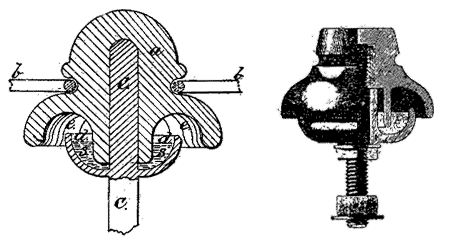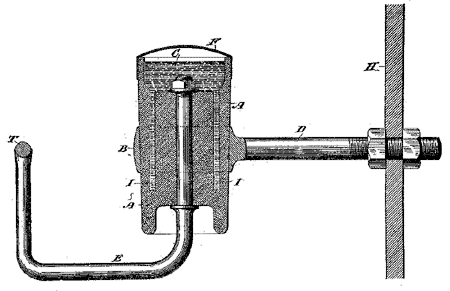[Trade Journal]
Publication: The Electrical Engineer
New York, NY, United States
vol. 12, no. 182, p. 471-472, col. 1-2
Oil Insulation for High-Tension Currents
BY Franklin Leonard Pope
The utilization of electrical energy for the transmission of power to great distances, which in one form or another bids fair to take a position as one of the most striking achievements of modern science, can, in most cases, only be rendered commercially advantageous by the employment of very high electric potentials. The conduction of currents at high pressures in turn makes it necessary that the utmost attention should be paid to the problem of securing adequate insulation. Recently the use of liquid insulators, especially the hydrocarbon oils, has found much favor, and materials of this nature are now being used with much success, not only for subterranean and aerial electric conductors, but for transformers and other like accessory apparatus. This method of insulation has been used in the Lauffen-Frankfort transmission system, recently described in The Electrical Engineer, in which a pressure as high as 18,000 volts has been dealt with, and apparently with the most satisfactory results. (1)
 |
| Figs. 1 and 2. |
The discovery of the valuable properties of the hydrocarbons as non-conductors of electricity appears to have been made by the late David Brooks, of Philadelphia, who, as the result of a long series of experiments, took out a patent on Nov. 29, 1864, No. 45,221; reissue, 2,717, for a telegraphic line insulator, in which the effective non-conducting substance was paraffine, of a waxy consistency. Prior to the date of Mr. Brooks's investigations, the text books and treatises on electricity had contained no allusion to the matter, beyond classifying "oils" among conductors, accompanied in some cases with the observation that the heavier oils were the better conductors. The paraffine insulator of Mr. Brooks proved to be a very effective one, and during the next ten or fifteen years he devoted himself assiduously to the task of introducing it into practical use on the telegraph lines of America. In this he was in a considerable measure successful, although his characteristically aggressive and uncompromising advocacy of his views, and his caustic criticisms - albeit well founded - of the generally prevailing conditions of insulation upon American telegraph lines, created an inimical feeling in influential telegraphic circles, which had the effect of largely preventing the introduction of what was unquestionably an improvement of the highest practical merit. In the latter patterns of the Brooks insulator a semi-liquid form of paraffine, enclosed in an inverted blown-glass bottle, has been employed. In warm weather the hydrocarbon flows sufficiently to renew its surface, and thus for a considerable period the deleterious effect of dirt upon the insulating surfaces is avoided.
A subsequent inventor, Mr. W. E. Simonds, of Hartford, Conn., now United States Commissioner of Patents, obtained a patent June 29, 1869 (No. 92,111), for an insulator for aerial conductors, in which he sought to avoid the objection just mentioned. In this insulator, a section of which, reproduced from the drawings of his patent, is given in Fig. 1, the body a of the insulator is made of any of the ordinary non-conducting substances, such as glass or porcelain, to which the conductor b is secured in the usual manner. The supporting pin c, of malleable iron, is formed with the cup d, whose edge or lip projects up into a groove, e, formed in the under side of the insulator proper. This cup is filled with liquid paraffine or other non-conducting oil, as shown at s. In his specification Mr. Simonds says:
"The placing of the insulating substance in the cup, and around the extension of the insulator proper, so as to form an unbroken continuous surface from the insulator proper to the inside of the cup, over which the electricity must pass in order to escape, is a new thing, and is my invention."
We recognize here the fundamental principle of that generic type of insulator in which a liquid surface of non-conducting oil is maintained between the conductor and its support, which surface encircles the inner surface of the insulator proper, and is in a great measure protected from the influence of dust and dirt. For some reason Mr. Simonds's invention never went largely into practical use, but it may nevertheless be conjectured that, had he been an electrical engineer, a manufacturer of supplies, or an officer of a telegraph company, rather than an attorney-at-law in a provincial city, his invention would hardly have been relegated to obscurity.
Several years later the English telegraphic engineers, W. C. Johnson and S. E. Phillips, reinvented and patented an insulator substantially the same as that of Mr. Simonds, though differing in some of its details, which, having been put on the market in various forms by this enterprising and well-known firm, has met with extended acceptance. (See British patent 3,534, of Sept. 8, 1876).
In their specification the inventors say that the principle of the invention is the "introduction of a liquid insulator between the line and the earth," which may be effected in several ways. An ordinary cup-shaped insulator may be inverted, filled with the liquid, and provided with a cover to exclude the rain, or an erect bell-shaped insulator may have its lip turned up inwardly so as to contain the liquid, or, lastly, a bell-shaped insulator may have within it a cup-shaped vessel turned up outwards. The liquid to be used in all cases is by preference a hydrocarbon "which will not support a film of moisture or dust on its surface." The accompanying illustration, Fig. 2, reproduced from The Telegraphic Journal of October 15, 1877, shows how nearly one of its forms resembles the one adopted by Simonds.
Most of the plants that have been established in Europe during the last few years for the transmission of electric power to considerable distances have found it necessary, or at least advantageous, to employ insulators embodying some one of the constructions pointed out in the Johnson and Phillips patent, as well as the general principle found in all these different forms suggested by them, for which principle we are indebted, in the first instance, to Mr. Simonds.
A still more recent improvement in the same line of invention, which seems likely to be of considerable importance, has just been patented by Robert J. Hewett, of St. Louis, Mo. Mr. Hewett has sought to provide for the constant and automatic renewal of a film of insulating oil, interposed between the electric conductor and the earth, so that its capacity to prevent the escape of the current cannot become impaired by exposure to dirt and moisture, even under the most unfavorable conditions, such, for example, as those affecting the conductor of an electric street railway when enclosed in an underground circuit. Mr. Hewett has ingeniously availed himself of a well-known, and often extremely troublesome property of the hydrocarbon oils, viz., their tendency to exude through minute capillary orifices in a containing vessel. One form of his invention is shown in Fig. 3, in which the body of the insulator A is of unglazed or partially glazed porcelain or other like material, held and supported by a collar, B, having a shank, D, secured to a suitable support, H, which is shown in the figure as the wall of the conduit.
 |
| Fig. 3. |
The upper portion of the insulator proper is formed into a receptacle, C, for containing a supply of liquid hydrocarbon, such as paraffine or rosin oil. The conductor T is attached to a stem or wire-holder, E, inserted in the body of the insulator.
The insulating surface is kept covered with a film of oil through the agency of ducts, I I, formed within the body of the insulator. These are kept filled from the receptacle C, and from them the oil slowly percolates through the porous material of the insulator, and flows in a thin stratum down along the external surface, dripping off at the lower edge. The non-conducting surface is thus constantly renewed with fresh oil, while any particles of dirt or conducting matter which may have lodged upon it are carried away. The receptacle C is covered with a cap, F, which may be removed when fresh oil is supplied.
In the Lauffen-Frankfort plant, the transformers have also been effectively insulated by the application of oil, in which the transformer is immersed. The credit of this idea seems to be also due in the first instance to Mr. Brooks. Of course, a transformer is nothing more or less than a mammoth induction coil, and the difficulties which arise in the insulation of the transformer are of the same character as those which have always been met with in the insulation of the induction coil. Mr. Brooks obtained a patent on December 17, 1878, in which he claimed as his invention a method of insulating induction coils or bobbins of wire of other electrical instruments, which consists in immersing them in a liquid insulating substance, by preference paraffine oil. It was while experimenting in connection with this invention that Mr. Brooks made the singular discovery that paraffine oil offers even a higher resistance than dry air to the passage of the electric spark.
Space does not admit more than a mere mention of the application of liquid insulation to subterranean and submarine conductors, another conception of the fertile mind of Mr. Brooks, which has proved to be of importance and value. But the increasing attention which is now being paid to the utility of this method of insulation for many purposes has suggested that it is due to the memory of Mr. Brooks and other early workers in this field that their labors should receive due recognition.
(1) THE ELECTRICAL ENGINEER, Sept. 30, pp. 370, 371.
